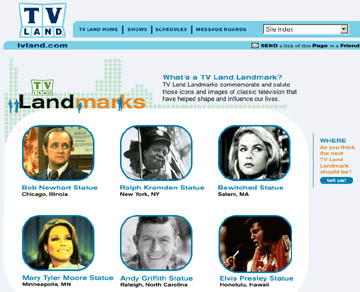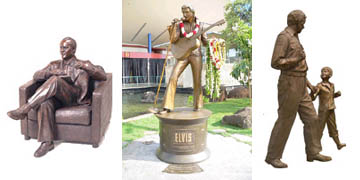On July 26, 2007, a bronze sculpture of young Elvis Presley was installed in Honolulu. The life-size figure is the sixth and final “TV LAND” donations to the citizens of NYC, Minneapolis, Salem (MA.), Chicago and Raleigh (N.C.). Except for Elvis, the artworks depict actors in their roles as popular characters from television shows of the 1950s, 60s and 70s. All are displayed in the actual cities that served as the settings for the fictional polite comedies. (Except Andy Griffith. See note)

TV Land Website on “Landmarks”
As Milwaukee announced that the tourism bureau was raising funds for “The Fonz” from “Happy Days”, I wondered about this industry of bronze figures. Many public art administrators and all contemporary art museums and centers ignore this group of artists like a disease – get too close and your professional career will be ruined. As a result, the museum crowd knows nothing about what is going on. We only come in contact with the industry when contemporary sculptures uses the same foundries, when conserving historic sculptures and when facing the disappointed citizen that cannot persuade the city arts commission to purchase a bronze figure.
Scottsdale Community Sculpture: A Scottsdale Mayor, Generic Officer, Scottsdale Founders
Artists: Clyde Ross Morgan, AZ Bronze, George-Ann Tognoni
Some agencies like Scottsdale, Arizona, have a special category for bronze sculptures. A community group secures approval for the project and location from the Arts Commission and then must raise the necessary funds. To facilitate, Scottsdale provides a list of sculptors and foundries.
In 2000, TV LAND initiated the program with Jackie Gleason as “Ralph Kramden” from the “Honeymooners”. Rather than curators or consultants, they turned to producer of artistic stuff like logos and award trophies – Robert Du Grenier. After deciding on the pose and other design elements with TV LAND, Du Grenier hired nearby artist Lawrence Nowlan to create the bronze figure. Not working out perfectly, for the “Mary Richards” sculpture related to the “Mary Tyler Moore Show”, TV LAND asked the City of Minneapolis to find the artist – Gwendolyn Gillen – and manage the project. Not working out perfectly, TV LAND turned to the big daddy of bronze and wax figurative production in the USA: Studio EIS of Brooklyn, NY. Elvis is their fourth sculpture for TV LAND.
TV Land: Samantha, Ralph and Mary
Producers & Artists: Studio EIS, DuGrenier/Nowlan, Gwen Gillen
Studio EIS: Large producer of bronzes from photographs

TV Land: Bob, Elvis and Andy
Producers: Studio EIS
Studio EIS clarified for me the purpose of these particular bronze sculptures in the public realm – a freestanding photograph. At the request of clients, EIS will take any photograph and convert it to bronze or wax or whatever material. The talented EIS artists reproduce, not interpret. The client evaluates through comparison with the original – not the person, but the key, publicly known photographic image. (Other foundries like Arizona Bronze and American Foundry will perform the same tasks)
For a minute forget all the stuff about men on horses and cultural prestige of bronze, see the sculpture as a picture in an album, book or local history museum. Wow, so that is what she looked like. I didn’t know he lived here. Funny shoes. I can’t believe people today like that monster. When I was a child, she walked up and down the street like she owned it.
The photograph generates these thoughts. As soon as the artistic interpretation expands beyond a little extra texture, the artist now interferes with the pure simple memory. The viewer must battle the artist.
Of course for the contemporary art community, feeling the artist is the point of most 20th century museum art. They want their preconception to be interfered with. They like the tension with or expression of the original person and artist’s vision. As Robert Venturi wrote in the 1960’s, “both/and.”
Despite the skills of the artists engaged in making these bronzes from photographs, the bronzes are not art at all. The key proof of this fact are the faces. The sculptures share a blandness of facial expression as if the artists knew they could not really bring the sculpture to life. Better not try. The client will complain.
These photographic bronzes will continue production and the Studio EIS method might be better than the sickly sweet or stiffly patriot figures. If any art administrator or leader of a memorial association is reading, please never permit the installation of these generic police officers with a child or two children on a bench. These figures attempt to convey the memory of a feeling or rather a feeling that SHOULD exist. I want my own feelings, so better to give me the photographic bronze of a real person or even TV character such that I might remember some real emotion.

Rocky and Sylvester in Philly. Bronze by A. Thomas Schomberg
ADDENDUM: THE FUTURE OF BRONZE SCULPTURE
This week on National Public Radio, Morning Edition ran a story on the disappearance of a 130 year-old sculpture of United States President Grant. Apparently, some people in the east African nation Guinea-Bissau stole and cutup the bronze bust into scrape metal – a valuable commodity in the country. In our “Green” age, perhaps bronze has an advantage: It is 100% recyclable.

President Grant sold as scrape metal in Guinea-Bissau (NPR story)
NOTES
1. Since Winston-Salem, North Carolina, is my hometown, I am of course insulted that either Mount Airy – the actual Mayberry from the Andy Griffith Show – or Winston-Salem – the actual city of Mount Pilot in the show – are not the home of the TV LAND sculpture. I don’t know how Raleigh stole the rights.
UPDATE: FROM JEFFERY YORK – Yes, unfortunately Raleigh was a recipient of the original statue, but shortly there after upon the instance of Andy Griffith and a vocal majority of Mt. Airy citizens, a second identical sculpture was produced for Mt. Airy. I attach an image of the sculpture outside the Andy Griffith playhouse in Mt. Airy, so you should no longer be disappointed. Mt. Airy now has “public art”.
2. Studio EIS is featured in an interesting History Channel documentary on the making of three wax sculptures of George Washington. A team of professors in Pittsburg used every peice of George Washington’s remains, paintings and artifacts to create 3D computer images of his face. Studio EIS converted the computer produced heads into the sculptures for Mount Vernon, Washington’s home in Virginia. Good program.
Digg it…Del.icio.us …Technorati…Stumble Upon..Reddit

Yeah, but it’s all tedious, threadbare, trite, shopworn, and sentimental realism-naturalism.
Yawn.
Gwen Gillen writes
(Artist of “Mary Richards” sculpture)
I’m not sure that I quite understand who’s ox is being gored. Is it the work of the individual artist, the Corporate Art Studio, or all who’s work represents Pop Culture? For my part, I work to bring to life the person I have been commissioned to portray, whether that represents a person in their own life or a person in their ficticious life, you’re still dealing with the real person. In fact, it’s more difficult to deal with sculpting a real person in their ficticious persona. You may be dealing with dueling personalities.
An artist is an artist, whether they work in a corporate structure or toil in their own studio. I do agree, that works that are churned out from some sculpture “factories” are really the work of craftsmen, not artists. That’s too bad, because there are so many good artists capableof producingmeaningful portrait works, both life size and monumental. Such is life.